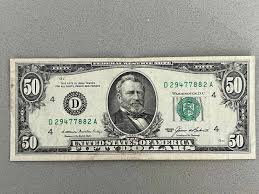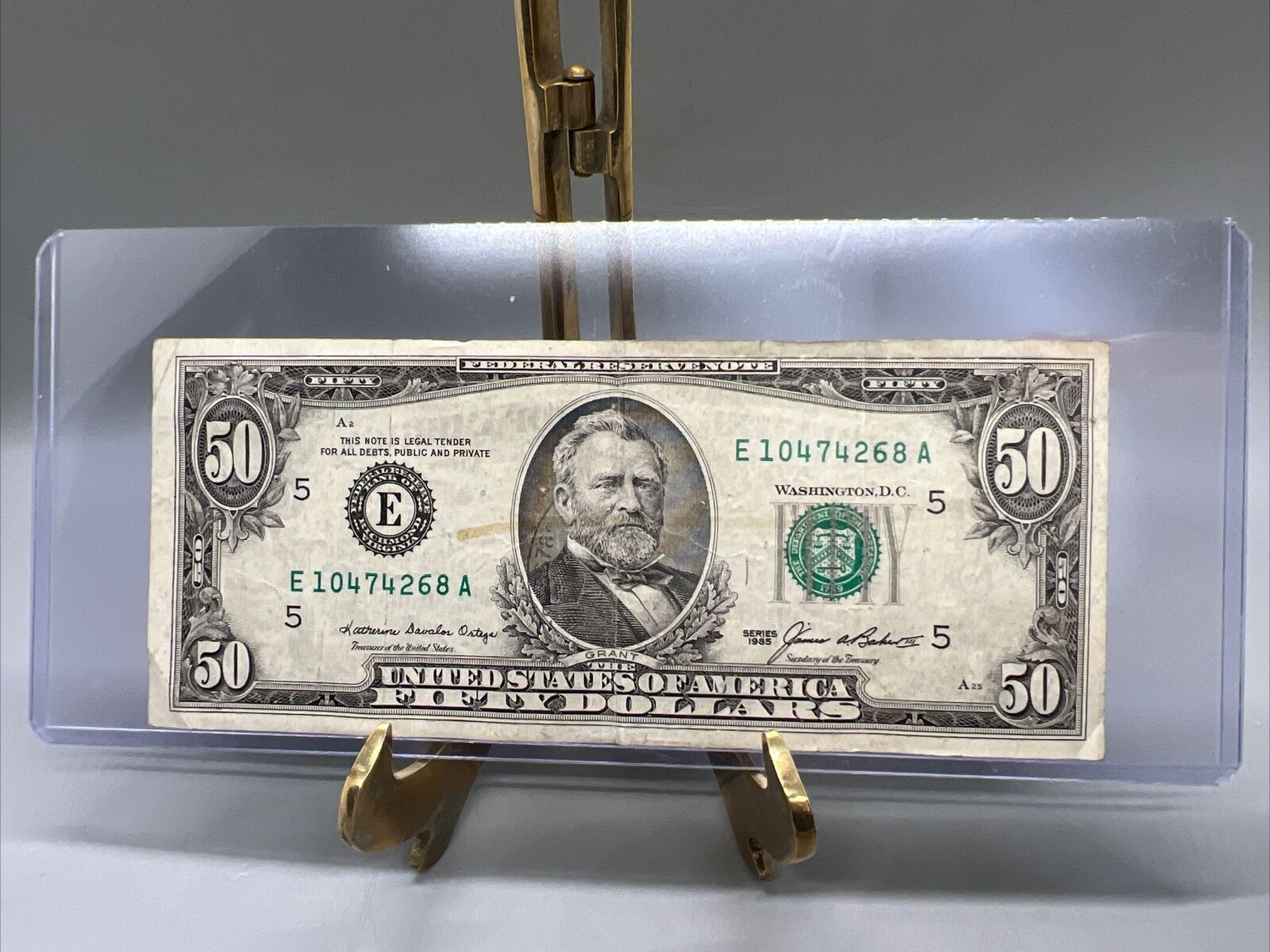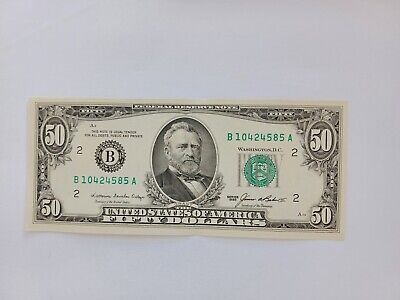The 1985 50 dollar bill, though largely common and easy to find, holds a unique place in the world of paper currency. A casual collector or a seasoned numismatist, you may wonder what makes this particular denomination noteworthy. Unlike rare historical notes, the 1985 fifty dollar bill has a distinct place in the history of US currency.
While most bills from this series aren’t worth much more than their face value, there are specific circumstances under which these bills can carry premium prices.
In this article, we will delve into the specifics of the 1985 50 dollar bill, how it compares to other bills of the same denomination, and what factors determine its value, including rarity, condition, and the significance of star notes.

If you happen to possess one of these bills, read on to learn if it’s worth more than just its face value.
1985 50 Dollar Bill Specifications and Features
Before exploring the worth of the 1985 $50 bill, it’s essential to understand the specifications of this currency note. The bill is part of the series issued in 1985 and features the traditional design elements seen in many US currency notes, including portraits of important historical figures.
The $50 bill in this series features a portrait of Ulysses S. Grant, the 18th President of the United States, alongside iconic symbols of American history.
Here are the key specifications for the 1985 fifty dollar bill:
- Denomination: $50.00 USD
- Type: Federal Reserve Note
- Signature Varieties: Ortega and Baker
- Series: 1985
- Portrait: Ulysses S. Grant
This bill also has numerous security features to prevent counterfeiting, including watermarks, security threads, and microprinting.
The most notable feature for the 1985 $50 bill, like other Federal Reserve Notes, is the embedded security thread visible when held up to light.
What is The Worth Of The 1985 $50 Bill?
For most collectors and those simply looking at the 1985 $50 bill as paper money, the value is generally not much higher than its face value of $50. However, as with many paper currencies, the value of the bill can vary significantly based on factors such as condition and rarity.
The majority of these bills in circulated condition are worth only their face value.
Condition is Key
As with any collectible item, the condition of the bill plays a major role in determining its worth. If your 1985 fifty dollar bill is in well-preserved, uncirculated condition, it can fetch a higher price.
Typically, an uncirculated 1985 $50 bill can be worth anywhere from $75 to $85, depending on the grade. Grading is essential in the currency world, and a bill that is graded MS 63, which indicates it is in choice uncirculated condition, will generally be worth more than one that has been in circulation for years.
In MS 63 condition, these bills are still crisp and well-centered, with no noticeable signs of wear and tear, making them a desirable item for collectors.
The highest value for standard bills, in uncirculated condition, can be found within the range of $75 to $85.
Star Notes: A Collector’s Dream
A key factor that can increase the value of any 1985 $50 bill is the presence of a star note. Star notes are replacement bills that the US Federal Reserve prints when errors are discovered during production. These notes have a star symbol at the end of their serial number, which distinguishes them from regular bills.
The rarity of star notes contributes significantly to their higher value. If you have a star note from the 1985 $50 bill series, it can be worth a substantial amount more than the standard bills.
Star notes in uncirculated condition with a grade of MS 63 can sell for anywhere between $200 and $250.
Furthermore, certain star notes issued by specific Federal Reserve Banks, like the Federal Reserve Bank of Cleveland, can reach prices of around $400 in top-tier condition.
This makes star notes highly sought after by collectors, especially those looking to add rare notes to their collection.
Factors That Affect the Value Of The 1985 $50 Bill
Aside from the general condition and star notes, several factors can influence the value of a 1985 fifty dollar bill. Some of these include errors in printing, the specific series of the bill, and even the geographic location from which the bill originated.

Error Bills: A Unique Find
While relatively uncommon, error bills can sometimes be found within a series. Errors in printing can include misaligned serial numbers, missing or doubled printing, and incorrect placement of security features.
A 1985 $50 bill that has an error might be more valuable to collectors, as these mistakes are rare and can be considered a piece of currency history.
These bills are especially coveted by collectors who specialize in printing errors and varieties. Depending on the severity of the error and its rarity, an error 50 dollar bill can carry a significantly higher value.
Series and Signature Variations
The 1985 series of the $50 bill also has different variations in signatures. The two primary signature varieties for this series are Ortega and Baker. While the difference may seem minor to some, collectors often seek specific signature combinations.
While these variations may not always dramatically affect the value of the bill, they do contribute to the overall appeal of certain notes.
A bill with a rare signature combination might be slightly more valuable than one with more common signatures, though this is often a more niche aspect of currency collecting.
The Influence Of Inflation
In terms of purchasing power, it’s interesting to compare the 1985 $50 bill to its value today. According to the inflation rate from 1985 to the present, $50 in 1985 would be equivalent to approximately $146.66 today.
This increase in value is due to inflation over the past 40 years, with an average inflation rate of 2.73% per year.
While this information may not directly impact the worth of the 1985 $50 bill in its current form, it highlights how currency value changes over time.
How To Tell If A 1985 $50 Bill is Real?
If you’re unsure whether the 1985 fifty dollar bill you’ve found is authentic, there are a few key security features to look for. One of the easiest ways to verify authenticity is to hold the bill up to light. When you do this, you should see a security thread running vertically to the right of Grant’s portrait.
This thread is imprinted with the text “USA 50” and should be visible from both sides. Under ultraviolet light, the thread will glow yellow, which is another easy way to determine if the bill is real.
Conclusion
The most 1985 50 dollar bill won’t bring you much more than their face value, collectors might still find value in uncirculated notes, particularly star notes or bills with rare printing errors.
Star notes are a great way to boost the value of your 1985 $50 bill, with certain notes fetching upwards of $400. Additionally, if you possess an uncirculated bill with a grade of MS 63, you can expect a premium over face value as well.
Though the 1985 fifty dollar bill isn’t inherently rare, the factors of condition, signature variations, and printing errors can make certain bills valuable collectibles. If you have a 1985 $50 bill that’s in great condition, it’s worth keeping an eye out for star notes or other unique features that could increase its worth.
The 1985 series is a fascinating part of the history of paper money, and even the most common bills can have surprising value under the right circumstances. The 1985 50 dollar bill worth is determined by its condition, rarity, and the presence of any unique features like errors or star notes.

